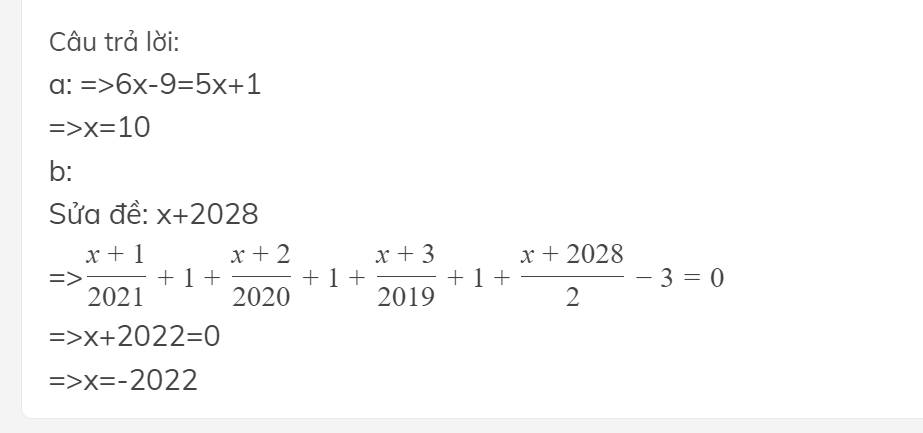giúp mình giải phương trình này với x+1/2023 + x-3/2021 = x+5/2010 + x+7/2017
Hãy nhập câu hỏi của bạn vào đây, nếu là tài khoản VIP, bạn sẽ được ưu tiên trả lời.


gọi 2021-x = a
2023-x=b
2x-4044=c
ta có a + b + c=2021-x+2023-x+2x-4044=0
suy ra a + b = -c
suy ra (a+b)^3 =-c^3
ta có a^3 + b^3 + c^3=(a+b)^3 -3ab(a+b) + c^3 = -c^3 +3abc +c^3 = 3abc
ta có (2021-x)^3 + (2023-x)^3 + (2x-4044)^3 = 0
=> 3(2021-x)(2023-x)(2x-4044)=0
=> th 1 x = 2021, th 2 x = 2023; th3 x = 2022

\(\dfrac{x-1}{2023}+\dfrac{x-2}{2022}=\dfrac{x-3}{2021}+\dfrac{x-4}{2020}\)
`<=>(x-1)/2023-1+(x-2)/2022-1=(x-3)/2021-1+(x-4)/2020-1`
`<=>(x-2024)/2023+(x-2024)/2022=(x-2024)/2021+(x-2024)/2020`
`<=>(x-2024)(1/2023+1/2022-1/2021-1/2020)=0`
`<=>x-2024=0(1/2023+1/2022-1/2021-1/2020>0)`
`<=>x=2024`
=>\(\left(\dfrac{x-1}{2023}-1\right)+\left(\dfrac{x-2}{2022}-1\right)=\left(\dfrac{x-3}{2021}-1\right)+\left(\dfrac{x-4}{2020}-1\right)\)
=>x-2024=0
=>x=2024

`2x-15=-25`
`2x=-10`
`x=-5`
___________
`3/5<x/10<4/5`
`3/5=(3xx10)/(5xx10)=30/50`
`x/10=(5x)/(10xx5)=(5x)/50`
`4/5=(4xx10)/(5xx10)=40/50`
`=>30/50<(5x)/50<40/50`
`=>30<5x<40`
`=>x=7`

a) \(-7x^2+10x-2016=-7\left(x^2-\frac{10x}{7}\right)-2016=-7\left(x^2-2.x.\frac{5}{7}+\frac{25}{49}\right)+\frac{25}{49}.7-2016=-7\left(x-\frac{5}{7}\right)^2-\frac{14087}{7}\le-\frac{14087}{7}\)Vậy Max = \(-\frac{14087}{7}\Leftrightarrow x=\frac{5}{7}\)
b) \(\frac{x+5}{11}+\frac{x+2010}{6}\ge\frac{x-1}{2017}+\frac{x+6}{2010}\)
\(\Leftrightarrow\frac{x}{2011}+\frac{x}{6}+\frac{5}{2011}+335\ge\frac{x}{2017}+\frac{x}{2010}-\frac{1}{2017}+\frac{1}{335}\)
\(\Leftrightarrow x\left(\frac{1}{2011}+\frac{1}{6}-\frac{1}{2017}-\frac{1}{2010}\right)\ge\frac{1}{335}-\frac{1}{2017}-\frac{5}{2011}-335\)
\(\Leftrightarrow\frac{677389259}{4076467935}x\ge\frac{-455205582048}{1358822645}\) \(\Leftrightarrow x\ge-2016\)
Câu b) còn cách khác nữa bạn nhé. Mình làm cách này "xù" quá ^^

Câu 1:
1: Ta có: \(P=\left(\dfrac{x^2}{x^2-3}+\dfrac{2x^2-24}{x^4-9}\right)\cdot\dfrac{7}{x^2+8}\)
\(=\left(\dfrac{x^2\left(x^2+3\right)}{\left(x^2-3\right)\left(x^2+3\right)}+\dfrac{2x^2-24}{\left(x^2-3\right)\left(x^2+3\right)}\right)\cdot\dfrac{7}{x^2+8}\)
\(=\dfrac{x^4+3x^2+2x^2-24}{\left(x^2-3\right)\left(x^2+3\right)}\cdot\dfrac{7}{x^2+8}\)
\(=\dfrac{x^4+5x^2-24}{\left(x^2-3\right)\left(x^2+3\right)}\cdot\dfrac{7}{x^2+8}\)
\(=\dfrac{x^4+8x^2-3x^2-24}{\left(x^2-3\right)\left(x^2+3\right)}\cdot\dfrac{7}{x^2+8}\)
\(=\dfrac{x^2\left(x^2+8\right)-3\left(x^2+8\right)}{\left(x^2-3\right)\left(x^2+3\right)}\cdot\dfrac{7}{x^2+8}\)
\(=\dfrac{\left(x^2+8\right)\left(x^2-3\right)}{\left(x^2-3\right)\left(x^2+3\right)}\cdot\dfrac{7}{x^2+8}\)
\(=\dfrac{7}{x^2+3}\)
Câu 2a đề sai, pt này ko giải được
2b.
\(P\left(x\right)=\left(2x+7\right)\left(x^2-4x+4\right)+\left(a+20\right)x+\left(b-28\right)\)
Do \(\left(2x+7\right)\left(x^2-4x+4\right)⋮\left(x^2-4x+4\right)\)
\(\Rightarrow P\left(x\right)\) chia hết \(Q\left(x\right)\) khi \(\left(a+20\right)x+\left(b-28\right)\) chia hết \(x^2-4x+4\)
\(\Leftrightarrow\left\{{}\begin{matrix}a+20=0\\b-28=0\end{matrix}\right.\) \(\Rightarrow\left\{{}\begin{matrix}a=-20\\b=28\end{matrix}\right.\)
3a.
\(VT=\dfrac{1}{1+x^2}+\dfrac{1}{1+y^2}=\dfrac{2+x^2+y^2}{1+x^2+y^2+x^2y^2}=1+\dfrac{1-x^2y^2}{1+x^2+y^2+x^2y^2}\le1+\dfrac{1-x^2y^2}{1+2xy+x^2y^2}\)
\(VT\le1+\dfrac{\left(1-xy\right)\left(1+xy\right)}{\left(xy+1\right)^2}=1+\dfrac{1-xy}{1+xy}=\dfrac{2}{1+xy}\) (đpcm)
3b
Ta có: \(n^3-n=n\left(n-1\right)\left(n+1\right)\) là tích 3 số nguyên liên tiếp nên luôn chia hết cho 6
\(\Rightarrow n^3\) luôn đồng dư với n khi chia 6
\(\Rightarrow S\equiv2021^{2022}\left(mod6\right)\)
Mà \(2021\equiv1\left(mod6\right)\Rightarrow2021^{2020}\equiv1\left(mod6\right)\)
\(\Rightarrow2021^{2022}-1⋮6\)
\(\Rightarrow S-1⋮6\)

<=>(x+1)3+x=x3+3x2+4x+1
=>x(x-1)2+5=x3-2x2+x+5
=>x3+3x2+4x+1=x3-2x2+x+5
=>x=\(\pm\frac{\sqrt{89}}{10}-\frac{3}{10}\)

Sửa đề: \(\dfrac{x+1}{2023}+\dfrac{x+3}{2021}=\dfrac{x+5}{2019}+\dfrac{x+7}{2017}\)
=>\(\left(\dfrac{x+1}{2023}+1\right)+\left(\dfrac{x+3}{2021}+1\right)=\left(\dfrac{x+5}{2019}+1\right)+\left(\dfrac{x+7}{2017}+1\right)\)
=>\(\dfrac{x+2024}{2023}+\dfrac{x+2024}{2021}=\dfrac{x+2024}{2019}+\dfrac{x+2014}{2017}\)
=>\(\left(x+2024\right)\left(\dfrac{1}{2023}+\dfrac{1}{2021}-\dfrac{1}{2019}-\dfrac{1}{2017}\right)=0\)
=>x+2024=0
=>x=-2024